Yan Qiao
OpenBench: A New Benchmark and Baseline for Semantic Navigation in Smart Logistics
Feb 13, 2025
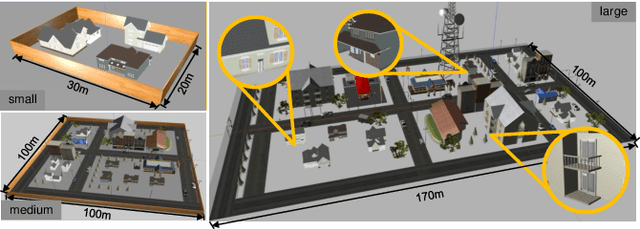

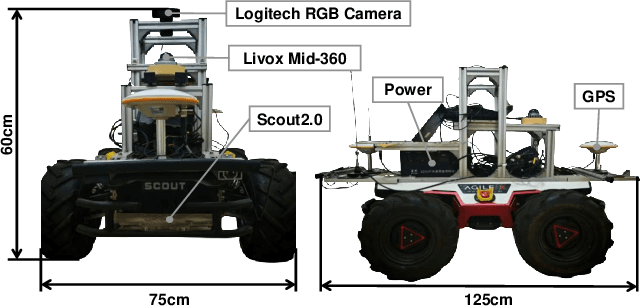
Abstract:The increasing demand for efficient last-mile delivery in smart logistics underscores the role of autonomous robots in enhancing operational efficiency and reducing costs. Traditional navigation methods, which depend on high-precision maps, are resource-intensive, while learning-based approaches often struggle with generalization in real-world scenarios. To address these challenges, this work proposes the Openstreetmap-enhanced oPen-air sEmantic Navigation (OPEN) system that combines foundation models with classic algorithms for scalable outdoor navigation. The system uses off-the-shelf OpenStreetMap (OSM) for flexible map representation, thereby eliminating the need for extensive pre-mapping efforts. It also employs Large Language Models (LLMs) to comprehend delivery instructions and Vision-Language Models (VLMs) for global localization, map updates, and house number recognition. To compensate the limitations of existing benchmarks that are inadequate for assessing last-mile delivery, this work introduces a new benchmark specifically designed for outdoor navigation in residential areas, reflecting the real-world challenges faced by autonomous delivery systems. Extensive experiments in simulated and real-world environments demonstrate the proposed system's efficacy in enhancing navigation efficiency and reliability. To facilitate further research, our code and benchmark are publicly available.
Learning-based Sketches for Frequency Estimation in Data Streams without Ground Truth
Dec 04, 2024Abstract:Estimating the frequency of items on the high-volume, fast data stream has been extensively studied in many areas, such as database and network measurement. Traditional sketch algorithms only allow to give very rough estimates with limited memory cost, whereas some learning-augmented algorithms have been proposed recently, their offline framework requires actual frequencies that are challenging to access in general for training, and speed is too slow for real-time processing, despite the still coarse-grained accuracy. To this end, we propose a more practical learning-based estimation framework namely UCL-sketch, by following the line of equation-based sketch to estimate per-key frequencies. In a nutshell, there are two key techniques: online training via equivalent learning without ground truth, and highly scalable architecture with logical estimation buckets. We implemented experiments on both real-world and synthetic datasets. The results demonstrate that our method greatly outperforms existing state-of-the-art sketches regarding per-key accuracy and distribution, while preserving resource efficiency. Our code is attached in the supplementary material, and will be made publicly available at https://github.com/Y-debug-sys/UCL-sketch.
Diffusion Models Meet Network Management: Improving Traffic Matrix Analysis with Diffusion-based Approach
Nov 29, 2024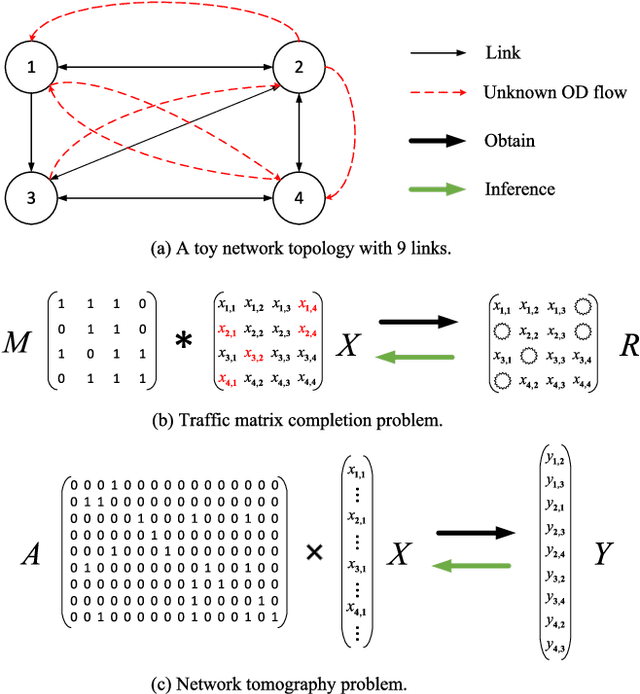
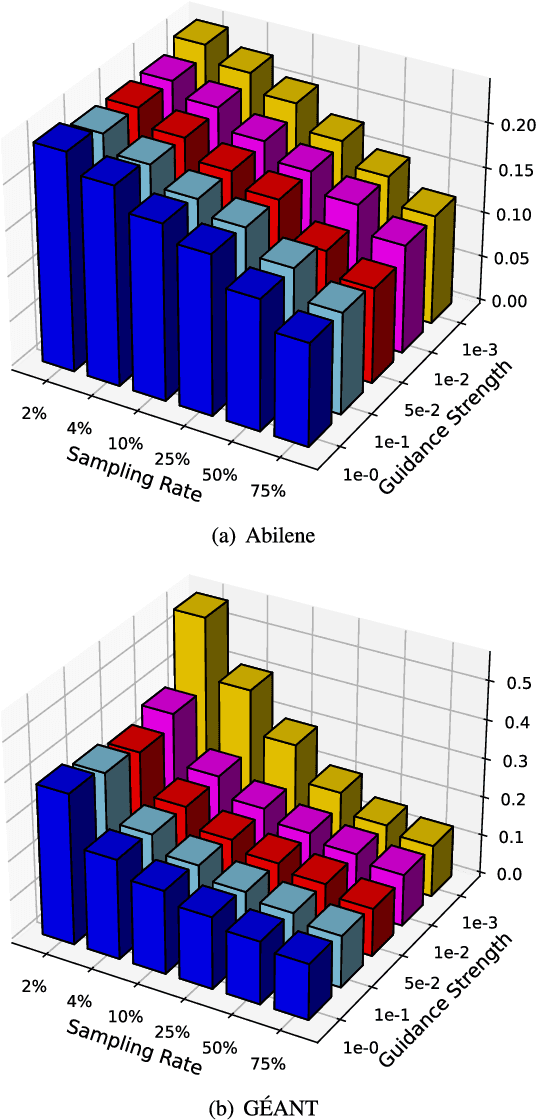

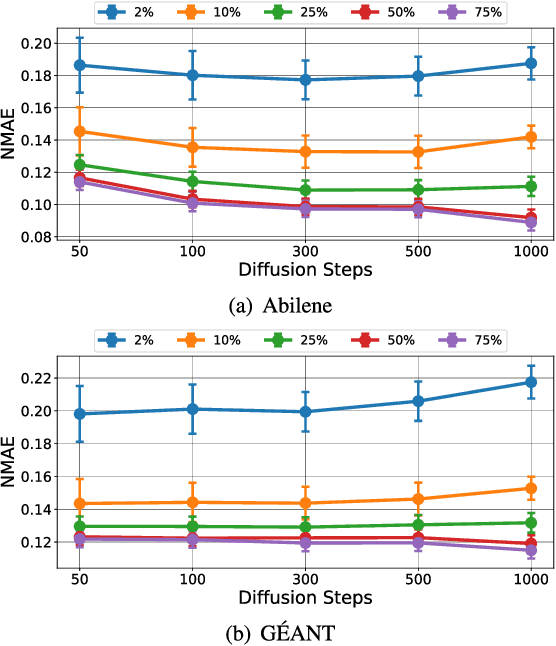
Abstract:Due to network operation and maintenance relying heavily on network traffic monitoring, traffic matrix analysis has been one of the most crucial issues for network management related tasks. However, it is challenging to reliably obtain the precise measurement in computer networks because of the high measurement cost, and the unavoidable transmission loss. Although some methods proposed in recent years allowed estimating network traffic from partial flow-level or link-level measurements, they often perform poorly for traffic matrix estimation nowadays. Despite strong assumptions like low-rank structure and the prior distribution, existing techniques are usually task-specific and tend to be significantly worse as modern network communication is extremely complicated and dynamic. To address the dilemma, this paper proposed a diffusion-based traffic matrix analysis framework named Diffusion-TM, which leverages problem-agnostic diffusion to notably elevate the estimation performance in both traffic distribution and accuracy. The novel framework not only takes advantage of the powerful generative ability of diffusion models to produce realistic network traffic, but also leverages the denoising process to unbiasedly estimate all end-to-end traffic in a plug-and-play manner under theoretical guarantee. Moreover, taking into account that compiling an intact traffic dataset is usually infeasible, we also propose a two-stage training scheme to make our framework be insensitive to missing values in the dataset. With extensive experiments with real-world datasets, we illustrate the effectiveness of Diffusion-TM on several tasks. Moreover, the results also demonstrate that our method can obtain promising results even with $5\%$ known values left in the datasets.
Traffic Matrix Estimation based on Denoising Diffusion Probabilistic Model
Oct 21, 2024



Abstract:The traffic matrix estimation (TME) problem has been widely researched for decades of years. Recent progresses in deep generative models offer new opportunities to tackle TME problems in a more advanced way. In this paper, we leverage the powerful ability of denoising diffusion probabilistic models (DDPMs) on distribution learning, and for the first time adopt DDPM to address the TME problem. To ensure a good performance of DDPM on learning the distributions of TMs, we design a preprocessing module to reduce the dimensions of TMs while keeping the data variety of each OD flow. To improve the estimation accuracy, we parameterize the noise factors in DDPM and transform the TME problem into a gradient-descent optimization problem. Finally, we compared our method with the state-of-the-art TME methods using two real-world TM datasets, the experimental results strongly demonstrate the superiority of our method on both TM synthesis and TM estimation.
Diffusion-TS: Interpretable Diffusion for General Time Series Generation
Mar 14, 2024Abstract:Denoising diffusion probabilistic models (DDPMs) are becoming the leading paradigm for generative models. It has recently shown breakthroughs in audio synthesis, time series imputation and forecasting. In this paper, we propose Diffusion-TS, a novel diffusion-based framework that generates multivariate time series samples of high quality by using an encoder-decoder transformer with disentangled temporal representations, in which the decomposition technique guides Diffusion-TS to capture the semantic meaning of time series while transformers mine detailed sequential information from the noisy model input. Different from existing diffusion-based approaches, we train the model to directly reconstruct the sample instead of the noise in each diffusion step, combining a Fourier-based loss term. Diffusion-TS is expected to generate time series satisfying both interpretablity and realness. In addition, it is shown that the proposed Diffusion-TS can be easily extended to conditional generation tasks, such as forecasting and imputation, without any model changes. This also motivates us to further explore the performance of Diffusion-TS under irregular settings. Finally, through qualitative and quantitative experiments, results show that Diffusion-TS achieves the state-of-the-art results on various realistic analyses of time series.
AI-based Modeling and Data-driven Evaluation for Smart Manufacturing Processes
Aug 29, 2020



Abstract:Smart Manufacturing refers to optimization techniques that are implemented in production operations by utilizing advanced analytics approaches. With the widespread increase in deploying Industrial Internet of Things (IIoT) sensors in manufacturing processes, there is a progressive need for optimal and effective approaches to data management. Embracing Machine Learning and Artificial Intelligence to take advantage of manufacturing data can lead to efficient and intelligent automation. In this paper, we conduct a comprehensive analysis based on Evolutionary Computing and Deep Learning algorithms toward making semiconductor manufacturing smart. We propose a dynamic algorithm for gaining useful insights about semiconductor manufacturing processes and to address various challenges. We elaborate on the utilization of a Genetic Algorithm and Neural Network to propose an intelligent feature selection algorithm. Our objective is to provide an advanced solution for controlling manufacturing processes and to gain perspective on various dimensions that enable manufacturers to access effective predictive technologies.
A security steganography scheme based on hdr image
Feb 28, 2019



Abstract:It is widely recognized that the image format is crucial to steganography for that each individual format has its unique properities. Nowadays, the most famous approach of digital image steganography is to combine a well-defined distortion function with efficient practical codes such as STC. And numerous researches are concentrated on spatial domain and jpeg domain. However, whether in spatial domain or jpeg domain, high payload (e.g., 0.5 bit per pixel) is not secure enough. In this paper, we propose a novel adaptive steganography scheme based on 32-bit HDR (High dynamic range) format and Norm IEEE 754. Experiments show that the steganographic method can achieve satisfactory security under payload from 0.3bpp to 0.5bpp.
 Add to Chrome
Add to Chrome Add to Firefox
Add to Firefox Add to Edge
Add to Edge